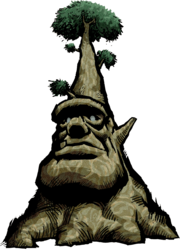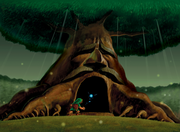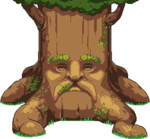| Don't like the ads? Then create an account! Users with accounts have more options than anonymous users. |
Great Deku Tree
| Great Deku Tree | |
|---|---|
 Artwork of the Great Deku Tree from The Legend of Zelda: The Wind Waker | |
| First appearance | The Legend of Zelda: Ocarina of Time (1998) |
| Latest appearance | Hyrule Warriors: Age of Calamity (2020) |
| Other form(s) | Deku Tree sprout |
| Counterpart(s) | Baga Tree Maku Tree (The Legend of Zelda: Oracle of Ages) Maku Tree (The Legend of Zelda: Oracle of Seasons) |
- “I have watched over Hyrule since time immemorial. Many have referred to me over the ages as the Deku Tree.”
- – Great Deku Tree, The Legend of Zelda: Breath of the Wild
The Great Deku Tree, sometimes shortened to simply the Deku Tree, is a massive, ancient, and wise tree who acts as the guardian spirit for the forest he resides. Although he is capable of preventing monsters from invading the forest, his immobility makes him easily susceptible to parasites and other ills.
History[edit]
The Legend of Zelda series[edit]
The Legend of Zelda: Ocarina of Time[edit]

In The Legend of Zelda: Ocarina of Time, the Great Deku Tree is the guardian of Kokiri Forest, and watches over the Kokiri and fairies there, who see him as a father-figure. In turn, he sees the Kokiri as his children, and is stated to have given life to them. Unlike later appearances, he is depicted as speaking in an old English-style dialect, and is seemingly unable to move anything but his mouth. He has a large nose, mustache, and eyebrows.
The Deku Tree provides the opening narration and as such has the first lines in the game. He introduces himself and explains the Kokiri to the player, then directs his attention to Navi, whom he orders to find "the boy without a fairy," Link, and bring him to him. Once Link arrives, the Deku Tree explains that an evil man from the desert cursed him with a parasite gradually sapping away at his health. He opens his mouth so Link can go inside him and destroy the monster.
Link is successful, but enough damage had already been done to cause the Deku Tree to begin dying regardless. Knowing the fate of Hyrule is in Link's hands now, he explains the legend of the three goddesses, the Triforce, and the Sacred Realm, saying that the power of the Triforce is what the evil man desires. He then grants Link the Kokiri Emerald, one of the keys to the Sacred Realm which the man, Ganondorf, was after. The Deku Tree then dies, turning a withered gray.
Seven years in the future, the lack of protection from the Deku Tree has caused Kokiri Forest to swarm with monsters. However, once Link completes the Forest Temple, a Deku Tree sprout grows in front of the original and resumes his role. He also explains to Link that he is a Hylian, not a Kokiri, and that the Deku Tree always knew Link was destined for a grand fate. It is never specifically made clear whether the sprout is merely an offspring of the Deku Tree or a reincarnation of it, though its knowledge on Link's past implies the latter.
The Legend of Zelda: The Wind Waker[edit]
In The Legend of Zelda: The Wind Waker, the Great Deku Tree, implied to be the grown-up Deku Tree sprout, appears as the guardian of the Forest Haven, thanking the Forest Water for his longevity. However, he acknowledges that with his immense age he has grown weak and may soon pass away, but that is merely the way of the world and not cause for sadness. He is also an earth spirit and the holder of Farore's Pearl. Like the other spirits, he speaks the ancient Hylian language, though unlike the others he is bilingual with the modern language. He now has a fully-moving face with visible eyes and a tooth, but without the eyebrows or facial hair. His canopy is much thinner than before, though the base of his trunk is wider and he is much taller. Additionally, the face is partway up his trunk, so to speak with him, Link needs to stand on a lily pad in front of him, which the Deku Tree then lifts with one of his roots. While he is secluded to the Forest Haven, he hopes that by spreading forest to other islands, he may some day reconnect the islands into one. The Kokiri he watched over have now evolved into the more tree-like Koroks.
When Link first finds the Deku Tree, his face is covered in red and green ChuChus. Link must knock them off with a roll and defeat them. After this, the Deku Tree sees Link's outfit and mistakes him for the Hero of Time he knew before, trying to speak to him in ancient Hylian. Realizing Link does not understand, the Deku Tree apologizes in the current language and introduces himself. He then calls for the Koroks to come out of hiding. He tells Link that they are about to begin their yearly ceremony to keep the forest healthy and add new trees to other islands, and that when it is done, he will give him Farore's Pearl. However, one of the Koroks, Linder, flies in to tell him that their violinist, Makar, has fallen into the dangerous Forbidden Woods. The Great Deku tree puts the ceremony on hold until Makar can return, and apologetically asks Link to rescue him. To help, the Deku Tree grows a Deku Leaf for Link to use, though since it is on some of the Deku Tree's highest branches, Link must use a sequence of Baba Buds to reach it.
Once Link and Makar have returned safely, the Deku Tree is relieved, telling Makar to be more careful from now on and giving Link the Pearl. After Makar apologizes, the Deku Tree tells him to cheer up and play his songs. The ceremony begins, and the Deku Tree happily dances to Makar playing and the other Koroks singing. At the end of the ceremony, the Deku Tree grows seeds in his branches, which all the Koroks except Makar and Hollo fly off to other islands, watching over the saplings until the next year. After this, Link may return to the Deku Tree at any point to ask about the forest and the Koroks. If he asks about the Koroks who flew away, the Deku Tree will mark the islands they flew to on Link's sea chart.
The Legend of Zelda: Breath of the Wild[edit]
In The Legend of Zelda: Breath of the Wild, the Deku Tree and Koroks reside in the center of the Great Hyrule Forest, in a glade called the Korok Forest. The Deku Tree has facial features similar to in Ocarina of Time, but with branches growing off his eyebrows. Additionally, the placement of his face is more similar to his appearance in The Wind Waker. He watches over the Master Sword, entrusted to him by Princess Zelda. In the Great Deku Tree's Navel are a few Korok-run businesses, and on the very top of him is a Korok named Walton.
When Link meets the Deku Tree, he wakes up from a nap, recognizes Link, and sardonically tells him he is late, noting that 100 years is taxing to even his patience. Realizing Link does not recognize him, the Deku Tree introduces himself and the Master Sword, telling Link it was the very blade he had wielded prior to the Great Calamity. He warns Link that attempting to draw the sword again will test his worth, slowly sapping at his health until it is pulled out or he stops. Once Link successfully pulls it, a memory is triggered of Zelda giving the Deku Tree the Master Sword. Zelda at first also wants the Deku Tree to relay a message to Link, though he points out it would sound better in her own voice. When the memory is over, the Deku Tree tells Link that even now, Zelda fights to keep Calamity Ganon sealed in Hyrule Castle. He also warns Link that the sword's power will temporarily wane if it is used too much against those not composed of or affected by malice.
The Legend of Zelda: Echoes of Wisdom[edit]
The Great Deku Tree appears in The Legend of Zelda: Echoes of Wisdom as a non-playable character.
Freshly-Picked Tingle's Rosy Rupeeland[edit]
In Freshly-Picked Tingle's Rosy Rupeeland, the Great Deku Tree resembles his appearance in The Wind Waker, but has a role more similar to in Ocarina of Time. He has a son, called Deku's Heir, who takes over his role after the Deku Tree dies from pollution.
Nintendo Land[edit]
In the Battle Quest mode of Nintendo Land, representations of the Deku Tree can be found in the Lost Woods section of the map. He also has a prize based on him.
Hyrule Warriors series[edit]
Hyrule Warriors[edit]
In Hyrule Warriors, the Deku Tree makes a few cameos, using his design from Ocarina of Time. His hollow, lifeless husk appears around the central keep in Faron Woods, and is set aflame by Wizzro in The Sorceress in the Woods. Additionally, a miniature version of him appears as part of an attack by Lana with her Spear, as well as in her victory cinematic with that weapon.
Hyrule Warriors: Age of Calamity[edit]
In Hyrule Warriors: Age of Calamity, the Deku Tree appears in the ending cutscene of Freeing Korok Forest, where he wakes up to see Link has drawn the Master Sword and thus must be the knight destined to seal the calamity. He also assures Zelda to no worry about her lack of success with her sealing power, as it will emerge in due time. He then apologizes before falling back to sleep.
Cadence of Hyrule: Crypt of the NecroDancer featuring The Legend of Zelda[edit]

In Cadence of Hyrule: Crypt of the NecroDancer featuring The Legend of Zelda, the Deku Tree appears in the "Symphony of the Mask" side-story, where he now watches over the Deku Scrubs of Deku Village as well as Skull Kid. In it, he summons Skull Kid to him and tells him that due to the rot of the land, he is nearly dead, believing Skull Kid to be destined to save the land. He instructs him to take the Skull Mask from the nearby Deku Hollow. Once he does so, the Deku Tree sees him off before withering.
If visited during the main campaign, the Deku Tree is not indicated to be ill and due to Skull Kid's fear, the player instead gets the mask for him. If spoken to, he recognizes the player character from before Ganon's takeover. If visited in the "Octavo's Ode" mode, he recognizes him as the same Octavo who fought Ganon, but notes there seems to be a difference.
Names in other languages[edit]
| Language | Name | Meaning |
|---|---|---|
| Japanese | デクの樹 Deku no Ki |
Deku Tree; from「木偶」(deku, wooden figure) |
| French | Arbre Mojo | Mojo Tree |
[Edit] Nintendo Land ("The Legend of Zelda: Battle Quest" mode)
| ||
|---|---|---|
| Enemies and bosses | Big Moblin • Bird • Chuchu • Ganon • Kargarok • Keese • Moblin • Quick Moblin • Skulltula • Stalfos • Tektite • Wizzrobe | |
| Obstacles | Arrow Trap • Bomb • Boulder | |
| Quests | ||
| Main quests | The Grasslands • The Lost Woods • Grassland Temple • Road to the Goron Mines • The Forest Temple Hunt • Death Mountain Climb • Gerudo Fortress Trail • Ganon's Castle Approach • Raid on Ganon's Castle | |
| Extra quests | The Sacred Grove • Journey to the Fire Temple • Death Mountain Path • Battle of Hyrule Field • Ganon's Last Stand | |
| Items | Arrow • Heart • Hylian Shield • Master Sword • Rupee • Triforce | |
| Miscellaneous | Great Deku Tree | |
- Trees
- The Legend of Zelda: Ocarina of Time characters
- The Legend of Zelda: The Wind Waker characters
- Freshly-Picked Tingle's Rosy Rupeeland characters
- Nintendo Land
- Hyrule Warriors
- The Legend of Zelda: Breath of the Wild characters
- Cadence of Hyrule: Crypt of the NecroDancer featuring The Legend of Zelda characters
- Hyrule Warriors: Age of Calamity characters